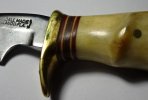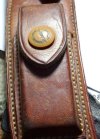alabamafats
Gold Member
- Joined
- Feb 20, 2024
- Messages
- 23
Cleaning Randalls is a broad subject area. I favor a coat of Renaissance Wax, for a collectable new or recent. Cleaning old Randalls is a whole different ball of wax.
I do not think patina on blades should be cleaned, or attempted to be cleaned. Verdigris on brass - left from remaining in a tanned leather sheath for example - is damaging to the brass it effects and can and will etch and corrode the metal. Thus I feel like green verdigris should be removed.
Question is how to do it...... A bright spot is left when the green is removed, particularly if a polish is used in removal. That doesn't look to good on an old and cherished collectable (I think). Does anyone have thoughts on this issue? Should such green be removed? If so, how? I have once used a toothpick and tiny wad of Never Dull on the end to gently rub such green away - slowly and carefully, of course - but that still left a bright spot where the green had been removed.
Would it be better to just go ahead and polish the whole thing (such as a double brass hilt)?
I would sure enjoy and benefit from some informed discussion. With the wealth of knowledge and experience in this forum we might be able to come up with a good idea and lessons learned... Thanks for the consideration. Respectfully and with Best Regards, alabamafats.
I do not think patina on blades should be cleaned, or attempted to be cleaned. Verdigris on brass - left from remaining in a tanned leather sheath for example - is damaging to the brass it effects and can and will etch and corrode the metal. Thus I feel like green verdigris should be removed.
Question is how to do it...... A bright spot is left when the green is removed, particularly if a polish is used in removal. That doesn't look to good on an old and cherished collectable (I think). Does anyone have thoughts on this issue? Should such green be removed? If so, how? I have once used a toothpick and tiny wad of Never Dull on the end to gently rub such green away - slowly and carefully, of course - but that still left a bright spot where the green had been removed.
Would it be better to just go ahead and polish the whole thing (such as a double brass hilt)?
I would sure enjoy and benefit from some informed discussion. With the wealth of knowledge and experience in this forum we might be able to come up with a good idea and lessons learned... Thanks for the consideration. Respectfully and with Best Regards, alabamafats.










